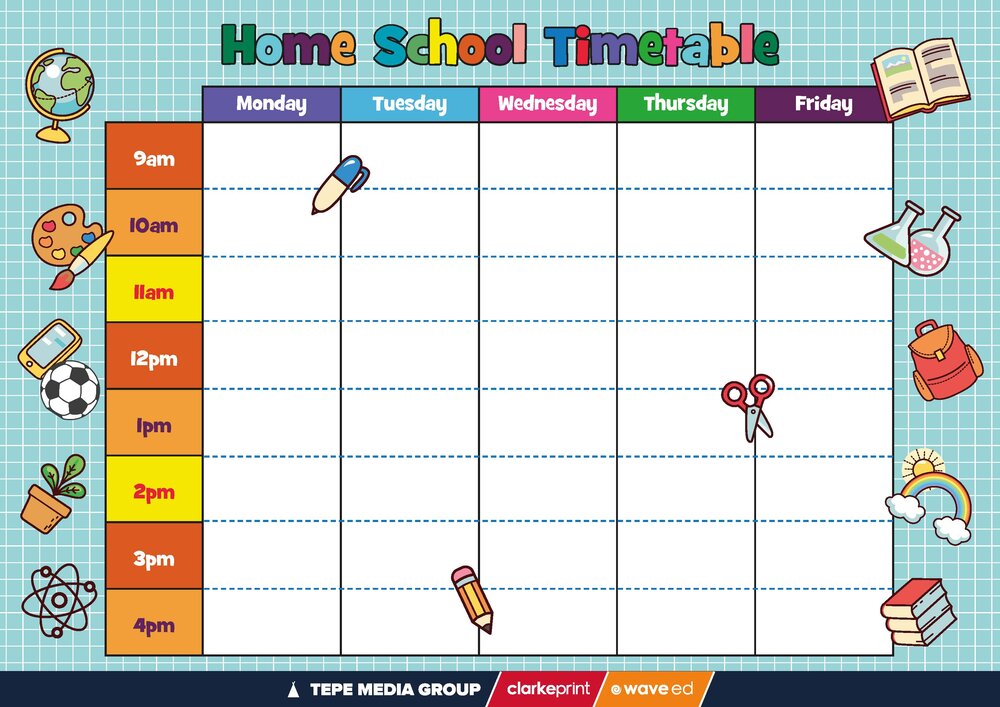Traditional schools excel in instilling discipline and managing students within a structured timetable. However, for parents venturing into homeschooling, a different set of skills is essential. Establishing a conducive learning environment involves more than just repetition; it requires a thoughtful and flexible approach tailored to the family’s lifestyle.
Types of Homeschooling
Before we talk about ways to create an effective daily homeschool schedule, we must learn about different types of homeschooling.
Here are some common approaches to learning at home:
- School at Home: This is the traditional way of homeschooling where children follow a full curriculum and learn from home. The lessons are scheduled based on what works best for parents or teachers.
- Online Public School: In this method, children are enrolled in a state-run public school but take their classes online from home. It follows the norms of a public school but without physical attendance.
- Unit Studies: This approach involves focusing on various subjects centered around a common theme, such as a historical event, a notable person, or a specific country. It’s also known as “interest-led” learning.
- Montessori: Although designed for group learning, Montessori principles can be applied at home. It focuses on teaching children as individuals through hands-on, real-world experiences rather than theory.
- Relaxed: As the name suggests, this method is largely unstructured. While the child follows a curriculum, there’s no strict schedule, providing a sense of freedom.
Crafting an Effective Homeschool Daily Schedule
Working from home introduces its own challenges, such as frequent interruptions, household chores, and external commitments. Designing a homeschooling schedule that aligns with the family’s existing routine is crucial. A successful schedule should accommodate the student’s interests and activities, striking a balance between academic pursuits, physical activities, self-study, and free time.
Maintaining a robust homeschool daily schedule requires adaptability. Priorities may shift, necessitating adjustments. Remember that even in traditional schooling, unforeseen absences occur. Thus, flexibility ensures the long-term plan remains intact.
Building a Well-Structured Daily Homeschool Schedule
Homeschoolers often adopt three primary schedule types:
- Block schedule: Focused study sessions on specific subjects.
- Classroom schedule: Mimicking a traditional daily class structure with breaks.
- Loop schedule: Gradual progression in difficulty for challenging topics.
The semester’s curriculum significantly influences the schedule. Planning ahead is key. Create a monthly plan outlining subject coverage, followed by weekly schedules and daily activities. While a structured plan is essential, avoid making it overly rigid, allowing room for adjustments as needed.
Embracing a Flexible Daily Routine
Avoid overburdening the weekly schedule. Some subjects may progress quickly, while others may require additional time. The advantage of homeschooling lies in adapting to the student’s pace. A flexible daily schedule accommodates slow phases without inducing stress for both the student and the parent.
Here’s a simple sample homeschooling daily schedule:
8:00 a.m. – Prayer/ Physical Education
9:15 a.m. – English
10:00 a.m. – Social Studies
10:45 a.m. – Break
11:00 a.m. – Science
11:45 a.m. – Language
12:30 p.m. – Math
1:15 p.m. – Lunch
1:45 p.m. – Project/ Reading
After the structured schedule, allocate time for hobbies, play, or additional assignments.
Developing Effective Lesson Plans
As the tutor, parents play a crucial role in creating lesson plans at monthly, weekly, and daily intervals. These plans ensure the curriculum progresses at a manageable pace, fostering focused discussions. Utilizing established curriculum patterns, such as CBSE or NIOS, provides access to valuable resources like books, online tuition, question banks, and test papers. If parents want to include more subjects or add something extra to the lesson plan, they can set aside some time each day to teach those subjects to their child and check how well they understand them.
In conclusion, embarking on the homeschooling journey requires thoughtful planning, adaptability, and a commitment to fostering an environment that nurtures both academic and personal growth. Crafting a well-structured homeschooling schedule, one that aligns with the family’s lifestyle and the student’s interests, is pivotal for success. The greatest strength of homeschooling lies in its ability to empower families to shape their educational journey with flexibility, creativity, and a deep understanding of their child’s unique learning style.
To learn more about how Schoolbase, in collaboration with NIOS, can support your child’s educational journey, connect with:
Mr Vinay Kumar
NIOS Cooridator
Ph: +91 6361938556.

